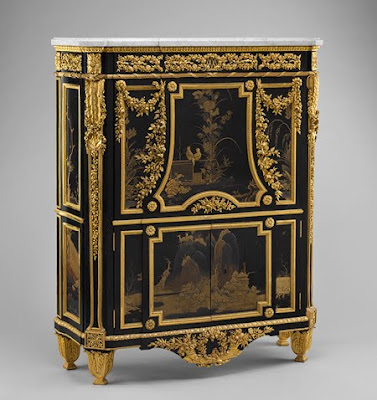
A foundry operating in 1901...

...and in 2009
The lost-wax method of casting metal, "cire perdue" in French, is thousands of years old and has changed very little in all that time. From small pieces of decorative hardware to statues of mammoth scale, the technique has been used the world over since as early as the 5th century BC.

The Berlin Foundry Cup depicts the process of casting bronze, 5th century BC.
The process begins with a model of the finished product, usually made of wax.

A plaster or clay mold is then made around that wax model.

Using that mold, a hollow wax casting is made.

That casting is encased in a fireproof mold of clay or plaster and fitted with sprues - tubes which will allow the melted wax to flow out of the mold when heated and the molten metal to be poured in.

Then the final cast is made and, once cooled, removed from the mold. Then the piece is "chased," meaning the sprues are cut off and piece is filed, buffed and polished to its final finish.

This painstaking process allows the most minute details to be rendered perfectly in solid metal, creating beautiful works of art and functional hardware.


The Thinker by Auguste Rodin, 1902, is a large scale cast bronze measuring over six feet tall.

The Chatsworth Head was found on the island of Cyprus in 1836 and dates to 460 BC, a remarkable early example of the "cire perdue" technique.

The Todai Daibutsu statue in Nara, Japan is a monumental cast bronze. Measuring 52 foot high and weighing 500 tons, the statue was constructed in eight castings over a three year period.

Bronze cat, Ptolemaic Period in Egypt, 305-30 B.C.

Many notable French cast bronze pieces, such as the King's Clock at the Palace of Versailles, are also gilded.

The Clock Room at Versailles

The King's Clock
The traditional method for this involves mixing a mercury amalgam with finely ground, high karat gold, applying this mixture to a cast bronze object, and then firing the object in a kiln. Due to the toxicity of working with mercury, this process is no longer employed.
The Rococo and Neoclassic pieces we prize today beautifully display this technique.

Neoclassic secretary by Jean-Henri Riesener, circa 1783

Rococo bronzes line the walls in the Hall of Mirrors at the Palace of Versailles
From sconces to andirons, chandeliers to dressers, the possibilities are endless... and beautiful!




No comments:
Post a Comment